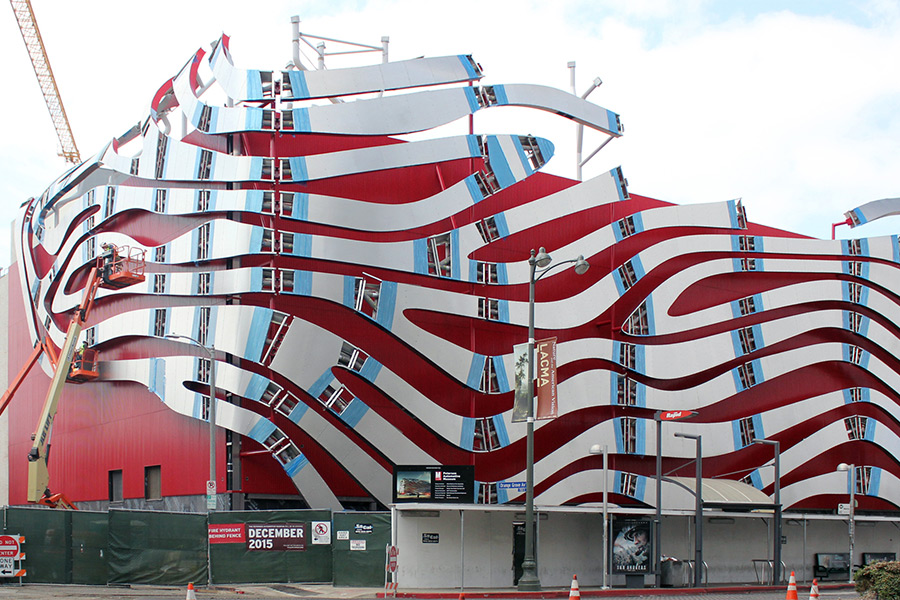
While Peter Zumthor and Renzo Piano’s plans for Los Angeles County Museum of Art (LACMA) and the Academy of Motion Picture Arts and Sciences have hogged the attention on LA’s Miracle Mile, the third museum commission in the area—Kohn Pedersen Fox Associates’ (KPF) reimagining of the Petersen Automotive Museum—is cruising along, so to speak, with completion planned for December.
The project, a new facade by KPF and a renovation of the interior galleries and administrative offices by House & Robertson and Scenic Route, was first announced in 2013. It is intended primarily to shine the spotlight on an institution that has long been overshadowed by its cultural neighbors. It wraps the existing building—a 1962 modernist department store by Welton Becket—in a veil of sinuous stainless steel ribbons whose liquid-like design echoes the speed of muscular automobiles. The ribbons are superimposed over a bright red custom corrugated metal rainscreen (“red is fast,” said KPF Principal Trent Tesch). That skin, anchored into the original building’s concrete columns, is made of 11-foot-by-4-foot panels.
The water-jet cut, angel hair stainless steel ribbons (their skins fastened to internal frames) are exposed in front and painted red on their edges and backs for depth and balance. Aluminum tubes inside help attach one piece to the next. The 26-foot, 6-inch-long ribbons, first designed in Rhino and adjusted with Grasshopper, were fabricated off-site. They are currently being hauled via truck to the site and being craned into place.
Workers for the project’s contractor, MATT Construction, needed a way to attach the ribbons to the building, so the project’s steel fabricator, Zahner, created a series of tubular steel and aluminum support structures, which KPF’s Tesch called “trees,” extending vertically from the roof and “shrubs,” outriggers projecting horizontally from the facade. (The veil wraps over the top of the building to create a dramatic, three-dimensional gesture and a rooftop outdoor space shaded by the ribbons.) The white trees and red shrubs are attached to the building’s existing columns and beams. In the few places where trees are not located directly over columns, the team installed a transfer beam to carry the load. When the ribbons extend to the ground they meet smaller steel “stumps,” as Tesch called them, which hold them in place.
The ribbons do not just wrap over the top of the Petersen; they project over the side, creating a gap between the building and the veil, which on the Wilshire side, visitors will be able to walk under in order to reach the museum entrance. The gap space ranges from just eight inches to about 25 feet along the length of the veil. The new entrance on Wilshire will bring the language of the ribbons inside with long lines of matte and glossy paint on the ceiling. This modern language was picked up by the museum’s interior designers, Scenic Route, which are opening up the galleries and giving them a contemporary look.
The new veil not only draws attention to the Petersen, but it unites its disparate parts and gives it a new sense of rhythm and depth. Say what you like about its brashness, this design will not get ignored. “They told us they were tired of living in a box,” said Tesch. Certainly things have changed.